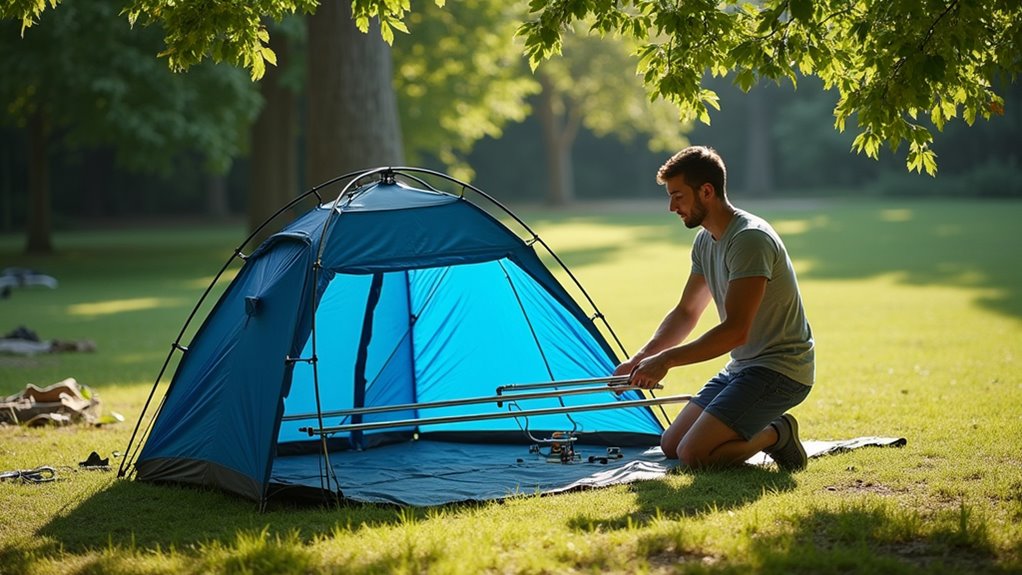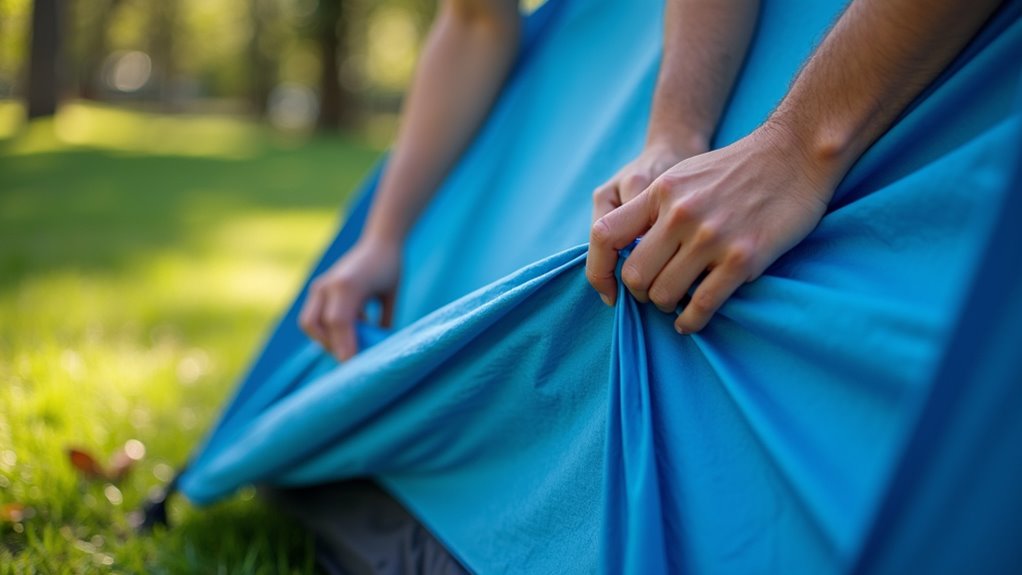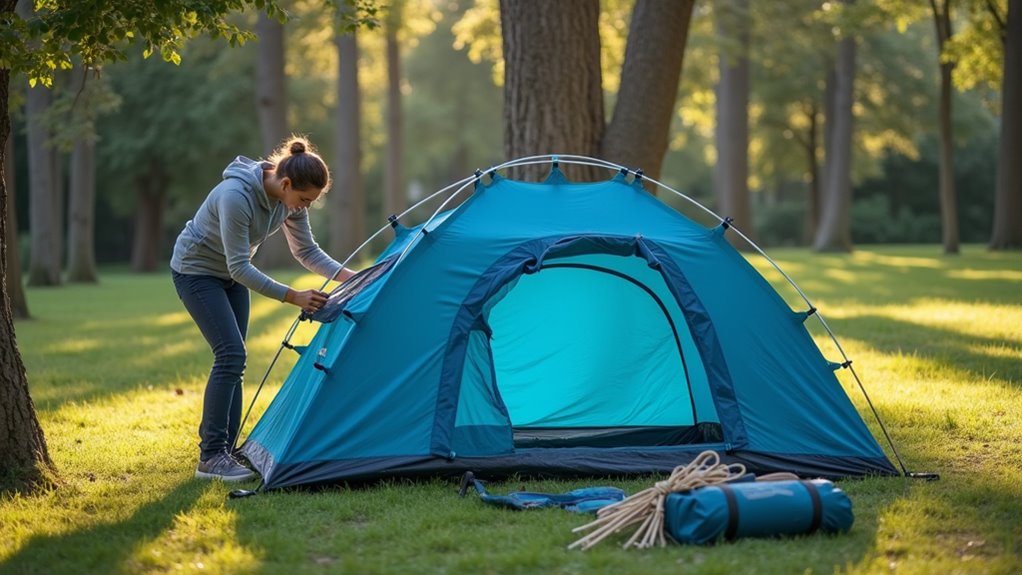How To Fold A Canopy Tent
This post contains affiliate links. As an Amazon Associate, we earn from qualifying purchases.
To fold a canopy tent, first remove all accessories such as sidewalls and weights, then lower the legs evenly after disengaging all frame locks. Next, fold the canopy fabric flat with loose folds toward the center and collapse the frame by releasing corner mechanisms and pushing it inward. Afterward, organize all components, inspect for any damage, and store everything properly for your next use. Further explanation and detailed tips for efficient packing will be provided later in this article for those interested.
Essential Facts in 30 Seconds
- Remove accessories and clear the area before folding.
- Lower each leg evenly, avoiding pinch points.
- Fold canopy fabric flat with loose folds.
- Collapse frame by releasing locks and pushing inward.
- Pack all components neatly and store in a dry place.
Disassembling the Canopy Tent Frame

First, unlock all locks on the frame carefully.
Lower each leg slowly to keep parts safe. Use the corner sliders or levers as the design shows.
Lower legs evenly to keep the frame balanced. Watch for pinch points to avoid hurting your fingers.
Handle sliders and joints with care. After legs fold, pull the frame sides together like an accordion.
Wind can make this tricky; ask for help if needed. Proper setup ensures protection against wind and weather.
Check all joints and sliders for damage or dirt. Clean parts to help the tent last longer.
Always put safety first to disassemble the tent properly.
Removing Accessories and Clearing the Area
Remove all accessories before folding your canopy tent. Take off sidewalls, weights, and awnings carefully. Untie Velcro and straps to avoid damage.
Clear tables, chairs, and personal items from under the tent. Check for stones or trash near the legs that can block folding. Dry wet fabric well to stop mold and mildew. It’s also a good idea to confirm all items inside the tent are removed to prevent leaving anything behind.
Ask friends to help and make space, especially if it’s windy. Put all accessories in one box to keep them safe.
Pick up trash and wipe away marks. Clean the area to leave it neat. Following these steps makes packing the tent easier and safer.
Folding the Canopy Fabric

Folding your canopy fabric the right way keeps it strong and good-looking.
Lay the fabric flat on a clean, dry spot. Make sure no dirt or moisture touches it. Fold the sides gently toward the middle. Use big, loose folds to protect the fibers. Tight creases can damage the fabric over time. Rolling works too, but roll softly and evenly. Avoid wrinkles.
Handle the edges carefully to stop fraying. Ask someone to help if the fabric is big. Check for dirt before you store it. Let the fabric rest a little to avoid sharp creases. Keep it in its bag. Store it away from sunlight.
These steps help your canopy last longer and look great.
Collapsing the Frame Properly
Collapse your canopy tent frame with care.
Release the frame mechanisms at each leg corner first. Press or pull the release buttons or pins to unlock them. Next, unlock the middle top frame locks to let the frame fold completely. Check all locking sliders to make sure they’re free. Remember to inspect for any damages before storage to ensure the tent remains in good condition.
Follow these steps for smooth frame folding:
- Push the frame inward evenly from one side.
- Squeeze the legs until the frame begins to close.
- Move the parts toward the center slowly and watch your fingers.
- Work evenly around the frame, applying equal pressure.
- Use your body weight to help if the frame is big.
Additionally, ensure that you remove any stakes and guylines before collapsing the tent, as this will facilitate a smoother process.
This way, your frame will collapse safely and easily every time.
Packing and Organizing Components

Collapse the frame first. Pack and organize all parts carefully. Sort the canopy fabric, frame, stakes, and ropes. Check that all pieces are present. Look over each item for damage or wear. Clean stakes and ropes to stop mold. It’s also important to check the condition of all items to avoid issues later. Use stakes for added stability to ensure the tent remains secure during transport.
Use this table to pack smartly:
| Component | Storage Solution |
|---|---|
| Canopy Fabric | Fold neatly, place at bag bottom |
| Frame | Wrap with bubble wrap, strap securely |
| Stakes and Ropes | Store in pouch or side pockets |
| Accessories | Use separate compartments |
Store the packed tent in a cool, dry spot. Do not put heavy things on top. This keeps the tent’s shape and quality. Follow these steps to keep your canopy tent ready for your next trip.
Frequently Asked Questions
How Do I Choose the Right Size Canopy Tent for My Needs?
Your event type and guest count guide the right canopy size. A 10×10 tent suits small groups, fitting about 10 people comfortably. For larger parties, tents like 10×20 or 20×20 work well. Each person needs around 10 square feet for seating and movement. Think about tables, chairs, and extra space for activities. Pick a tent size that keeps everyone comfortable and sheltered. Simple math helps: multiply guests by 10 to find needed square feet. This way, the canopy fits your event perfectly.
Can I Wash the Canopy Fabric in a Washing Machine?
Machine washing canopy fabric can damage it badly. The fabric may shrink, tear, or lose its water resistance. Use a soft brush or sponge with mild soap and cold water instead. Rinse well and air dry in shade. This method keeps the fabric strong and looking good for many uses. Treat your canopy gently to help it last longer and stay beautiful.
What Materials Are Used in Canopy Tent Frames?
Canopy tent frames use mainly aluminum or steel. Aluminum is light and does not rust easily. Steel is strong and costs less. Steel can rust without care. Rust can shorten the frame’s life. Aluminum lasts longer but weighs less. Both materials have good uses for tents.
How Can I Repair Small Tears in the Canopy Fabric?
Small tears in canopy fabric need quick fixes to last long. First, clean the torn area well. Dirt and dust stop patches from sticking. Next, cut a fabric patch slightly bigger than the tear. Use fabric glue to stick the patch on the tear. Press firmly and smooth out bubbles. Wait at least 24 hours for the glue to dry completely. This step makes the repair strong and weatherproof. Regular checks help catch new tears early. This simple repair can save your canopy from bigger damage.
Are There Any Specific Care Instructions for Different Fabric Types?
Proper care can make your canopy last up to 50% longer. Different fabrics need different care. Polyester needs gentle washing and air drying to avoid damage. Vinyl requires wiping with a soft cloth and mild soap. Canvas should be cleaned with cool water and left to dry fully. Always avoid harsh chemicals and direct heat. These simple steps keep your fabric strong and looking good.
Conclusion
Folding your canopy tent is simple and quick. First, take apart the metal frame carefully. Next, remove any accessories, like sidewalls or weights. Lay the fabric flat and fold it neatly. This keeps the tent clean and easy to carry. Store all parts together in one bag. This way, you won’t lose anything. Practice a few times and you will fold the tent faster each time. Ready for your next outdoor event? You got this!
